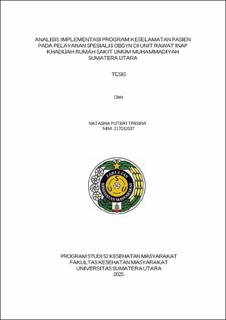Analisis Implementasi Program Keselamatan Pasien pada Pelayanan Spesialis Obgyn di Unit Rawat Inap Khadijah Rumah Sakit Umum Muhammadiyah Sumatera Utara
Analysis of Patient Safety Program Implementation in Obstetrics and Gynecology Specialist Services at the Inpatient Unit of Khadijah Muhammadiyah General Hospital North Sumatera

Date
2025Author
Trisira, Natasha Puteri
Advisor(s)
Zulfendri
Nasution, Siti Khadijah
Metadata
Show full item recordAbstract
Patient safety is a fundamental aspect of healthcare services, particularly in obstetrics and gynecology (Ob-Gyn) units. The six patient safety goals that serve as primary standards include accurate patient identification, effective communication, medication safety enhancement, surgical site and procedure verification, infection risk prevention, and patient fall risk reduction. This study employs a qualitative approach using the realistic evaluation method to assess the implementation of patient safety goals in the Khadijah Inpatient Unit at Muhammadiyah Hospital, North Sumatra. Data were collected through in-depth interviews with medical and support personnel, direct observations, and document analysis, followed by thematic analysis. The findings indicate that patient identification accuracy is maintained through identification wristbands and double verification before medical procedures, although occasional mismatches still occur. Effective communication is implemented via medical record documentation and a read-back policy, yet challenges remain due to varying levels of understanding and insufficient coordination during shift changes. Medication safety is improved through electronic documentation; however, dosage errors persist and should be minimized through a double-verification system. Surgical site and procedure verification are enforced via site marking, though unconscious patients pose challenges in active verification participation. Infection prevention measures include sterilization procedures, regular training, and infection surveillance, yet stricter monitoring is necessary for optimal program effectiveness. Patient fall risks are mitigated through initial risk assessments and assistive equipment, though the lack of facilities such as bedside steps and limited medical staff remain significant challenges. Overall, the implementation of the six patient safety goals in the Khadijah Inpatient Unit has been relatively effective; however, optimization is still required in terms of facilities, training, and inter-professional communication. Strengthening team coordination and improving support infrastructure are crucial steps in enhancing patient safety.
Collections
- Master Theses [2429]
